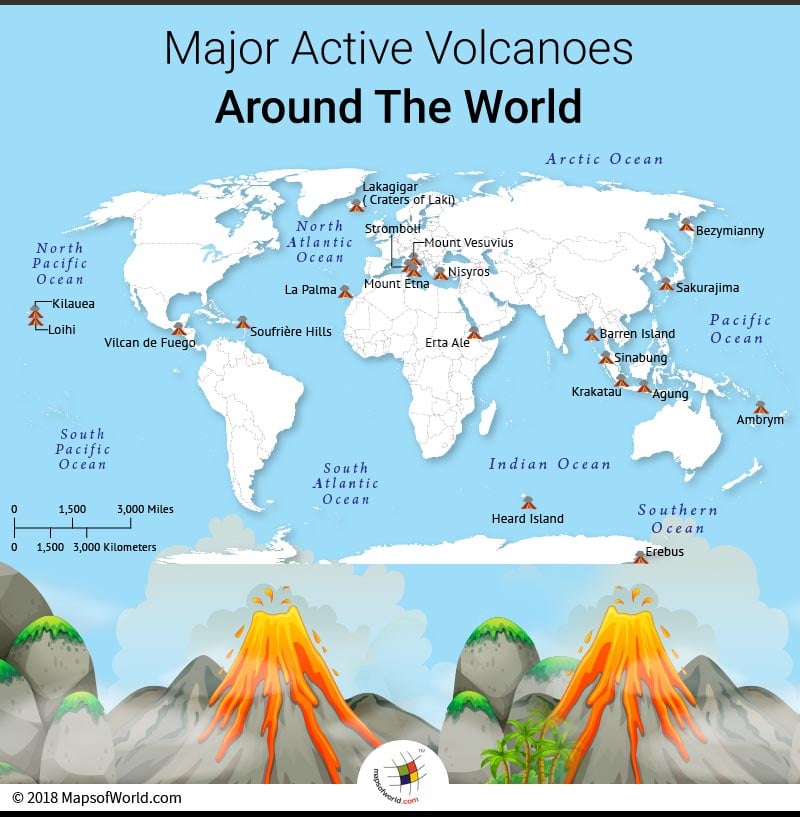

A volcano is a rupture in the earth's surface, on the crust layer, that allows the escape of lava, volcanic ash and gases from a magma chamber in the earth's inner layers.
A volcanologist studies the eruptive activities, and formation of volcanoes as well as collects the materials from the eruption to understand and predict the next eruption in order to manage disasters and corresponding earthquakes.
A volcano is a rupture in the earth’s surface, on the crust layer, that allows the escape of lava, volcanic ash, and gases from a magma chamber in the earth’s inner layers. An active volcano is a type of volcano that has erupted at least once in the last 10,000 years. A currently erupting volcano is categorized as an active volcano whereas one bound to erupt in the near future is a dormant type of active volcano. The distinction varies since the lifespan of the volcanoes can spread from months to several million years, but it is largely the underneath activity in the earth’s interior, that helps define the kind of volcano and predict its eruption to a certain level.
The presence of volcanoes is largely found in the converging or diverging plate tectonics of the earth, which floats on the softer and hotter layer of the mantle. These are due to the breaking of the earth’s crust as well as it’s stretching and thinning. These volcanic-rich regions are called the hotspots of the earth. There are approximately 500 volcanoes on the earth’s surface. Hence, there arises a need to learn a few of the active volcanoes to understand their composition and type and understand the properties of these volcanoes and their eruptions.
The few of the most active volcanoes on the earth’s surface are:
Below lying table mentions the most active volcanoes and their locations:
| Volcano’s Name | Regions | Country |
|---|---|---|
| Barren Island | Andaman and Nicobar Islands | India |
| Erta Ale | Afar Region | Ethiopia |
| Vilcan de Fuego | Central America | Guatemala |
| Heard Island and McDonald Islands | Antarctic | Australia |
| Kilauea | U.S. Hawaiian Island | Hawaii |
| Lakagigar ( Craters of Laki) | North Atlantic | Iceland |
| La Palma | Canary Islands | Spain |
| Loihi | U.S. Hawaiian Island | Hawaii |
| Mount Erebus | Antarctica | New Zealand |
| Mount Etna | Sicily, Mediterranean Sea | Italy |
| Nisyros | Aegean Sea | Greece |
| Soufrière Hills | Caribbean | Montserrat (UK) |
| Stromboli | Tyrrhenian Sea | Italy |
| Mount Teide | Canary Islands | Spain |
| Mount Vesuvius | Gulf of Naples | Italy |
| Bezymianny | Kamchatka | Russia |
| Sakurajima | Kyushu | Japan |
| Mount Sinabung | North Sumatra | Indonesia |
| Krakatau | Sunda Strait | Indonesia |
| Mount Agung | Bali | Indonesia |
| Ambrym | Malampa Province | Republic of Vanuatu |
Know more:
Related maps:
The Republic of Madagascar is an island country located in the Indian Ocean, off the…
The Euro is the official currency of the European Union. It is, however, not incumbent…
There are many countries or regions that are partially recognized by the UN, have disputes…
The Alaska Statehood Act was signed into law by President Dwight D. Eisenhower in 1958,…
The name Persia may, however, only be used to refer to Iran in some contexts.…
Hawaii is an Island State in the US. It is one of the 50 states…